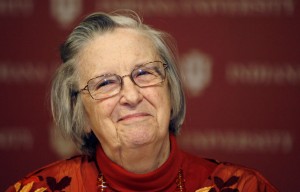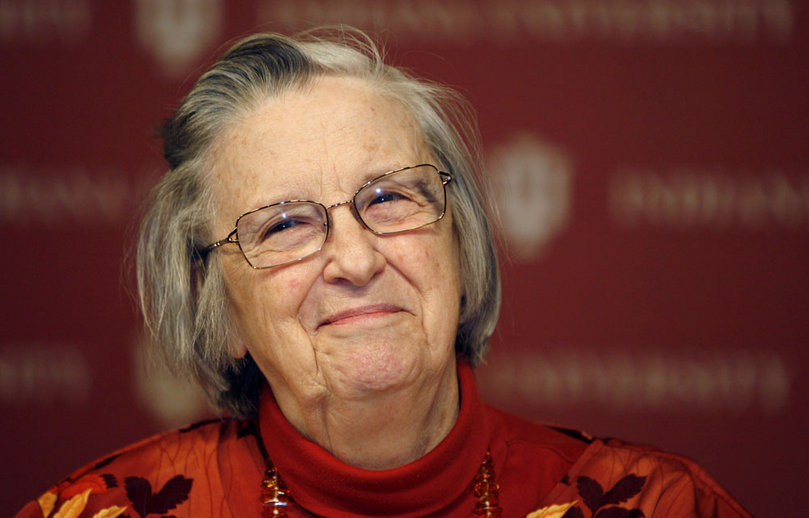 “We can’t just sit around waiting for the global solution,” says Dr. Elinor Ostrom regarding climate change. “There is a lot that can be done at a household level, at a community level, at a regional level.”
“We can’t just sit around waiting for the global solution,” says Dr. Elinor Ostrom regarding climate change. “There is a lot that can be done at a household level, at a community level, at a regional level.”
Ostrom, a professor at the University of Indiana in Bloomington and the first woman to receive the Nobel Prize in Economic Sciences (2009), opposes the pessimistic argument that assumes that human beings have become a plague on the planet, condemned to exhaust the resources that provide their support, and that the only possible way to stop environmental devastation is through privatization or autocratic regulations. According to Ostrom, there is a third way to reach a solution, which is the creation of cooperative institutions organized and governed by the same citizens that need to utilize these common resources and that would commit to do it in a sustainable manner, respecting their recovery time.
“Having studied a lot of farmer-managed irrigation systems, I’ve seen farmers handle water in a way that is remarkable and better than some governments,” says Ostrom, who was awarded the Nobel Prize precisely for her studies on the sustainable governance of common resources.
During three decades, Ostrom and her colleagues studied and observed the way in which small and medium-size groups around the world assumed the responsibility of organizing the management of resources owned in common, how they created systems of social interaction, decision-making procedures, how they established regulations through mutual agreements and how they devised procedures to follow and to resolve conflicts of interest.
Even though not all local groups were equally effective, their studies showed that it is not only possible for people to organize efficiently to better manage environmental resources, but they also showed the importance of economic analysis to understand the mechanisms that govern those social organizations, as well as the circumstances that render the best results.
“Trust is the most important resource. If a community has been forbidden from managing it’s resources for a long time, the main obstacle to overcome is the lack of trust and the effort to get organized in the first place. It’s not a trivial matter,” says Ostrom.
This does not mean that Ostrom underestimates the role of the State in self-organization, but she considers that this role loses its effectiveness if governments begin by developing strict norms and positioning themselves above the communities. She works with the concept of polycentrism, acknowledging the existence of multiple-level systems and diverse options to solve problems, and where governments are not expected to solve all issues, but instead, they are regarded as a link between individuals participating and collaborating in the management of property owned in common. According to Ostrom, when governments set rules and bans when people do not participate in the planning and deliberation process, efforts are duplicated, and as a result resources and effectiveness are lost.
Ostrom highlights the need to respect the wisdom of the communities that have solved their problems with ingenuity and limited resources throughout different generations, and brings about the following example: “In a developing country like Nepal, they invested millions of dollars in hardware, but the engineers never looked at property rights so they placed cement right over the exit for a water system that has several hundred years of history.”
Polycentrism does not mean replacing the State or working outside its realm, but it means assuming an active role and not expecting all the solutions to magically appear.
“My husband’s mother was in a homemakers club that was started by an extension group in Washington State,” recounts Ostrom. “They met once a week for 40 years and they made quilts. Some of the quilts were put aside for community emergencies because they were using wood stoves and the house burned from time to time. If somebody’s house burned, they had quilts made already, people would help rebuild it as a community project and they could be back into reasonable housing within a short period of time.”
“When we cleared out her home after she passed away, there were books on how to can things so they remained healthy, how to check your water, all sorts of handy how-to-do things. This was a poor neighborhood. My husband’s parents didn’t have running water in the house until after he left and went to college. He had to carry it. But they understood about boiling their drinking water and all sorts of other things. His mom had a wood stove; not the most efficient one, but she made a good pie every day! See, that is polycentric!”
So what would be the role of corporations as polycentric agents in a community that manages its own resources? “It depends on the business,” Ostrom says. “Some business could care less. Some business is exploitative and just looking for cheap labor and other businesses are trying to be local, get products that are identifiable with a region and build the region. It is the difference between an international firm, as some of the paper companies, and a small business that is a co-op or small private business that has deep roots in the community. They want to see their community get better!”
Ostrom, an optimistic, down-to-earth and amiable woman who has built an admirable academic reputation observing with thoroughness and profound respect the way in which citizens from different cultures gather and work together to solve the serious problems they face in their natural environments, seems to have adopted Einstein’s dictum as the norm for her professional work: “The significant problems we face cannot be solved at the same level of thinking we were at when we created them.”
“We need to get people away from the notion that you have to have a fancy car and a huge house,” Ostrom says. “Some of the homes that have been built in the last 10 years just appall me. Why do humans need huge homes? I was born poor and I didn’t know you bought clothes at anything but the Goodwill until I went to college. Some of our mentality about what it means to have a good life is, I think, not going to help us in the next 50 years. We have to think through how to choose a meaningful life where we’re helping one another in ways that really help the Earth.”
————————
Note of the Foundation: Elinor Ostrom was born on August 7, 1933, in Los Angeles. She was educated at the University of California at Los Angeles, completing her BA with honors in 1954. She completed her MA in 1962 and her Ph.D. in 1965. At the University of California at Los Angeles, she met and married Vincent Ostrom, a political scientist. The Ostroms moved to Indiana in 1965 when he got a teaching position in the political science department. At the same time, she did her career as faculty and she was a Distinguished Professor at Indiana University and the recipient of the University Medal as well as scores of other honors, including, as we pointed out above, the Sveriges Riksbank Prize in Economic Sciences in Honor of Alfred Nobel. Our member of the Board, Marta Escotet, interviewed her in the Fall of 2010, just a year and a half before she passed away on June 12, 2012. We are reproducing excerpts from the full interview published previously a decade ago in our Foundation, to express the up-to-date of her thinking and her anticipation for the future. Fall of 2020.



